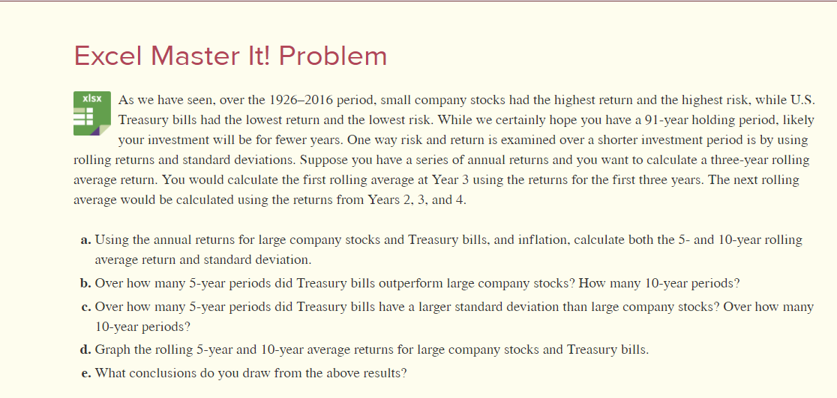
Excel Master It! Problem xlsx As we have seen, over the 1926-2016 period, small company stocks had the highest return and the highest risk, while U.S. Treasury bills had the lowest return and the lowest risk. While we certainly hope you have a 91-year holding period, likely your investment will be for fewer years. One way risk and return is examined over a shorter investment period is by using rolling returns and standard deviations. Suppose you have a series of annual returns and you want to calculate a three-year rolling average return. You would calculate the first rolling average at Year 3 using the returns for the first three years. The next rolling average would be calculated using the returns from Years 2, 3, and 4. a. Using the annual returns for large company stocks and Treasury bills, and inflation, calculate both the 5- and 10-year rolling average return and standard deviation. b. Over how many 5-year periods did Treasury bills outperform large company stocks? How many 10-year periods? c. Over how many 5-year periods did Treasury bills have a larger standard deviation than large company stocks? Over how many 10-year periods? d. Graph the rolling 5-year and 10-year average returns for large company stocks and Treasury bills. e. What conclusions do you draw from the above results? Excel Master It! Problem xlsx As we have seen, over the 1926-2016 period, small company stocks had the highest return and the highest risk, while U.S. Treasury bills had the lowest return and the lowest risk. While we certainly hope you have a 91-year holding period, likely your investment will be for fewer years. One way risk and return is examined over a shorter investment period is by using rolling returns and standard deviations. Suppose you have a series of annual returns and you want to calculate a three-year rolling average return. You would calculate the first rolling average at Year 3 using the returns for the first three years. The next rolling average would be calculated using the returns from Years 2, 3, and 4. a. Using the annual returns for large company stocks and Treasury bills, and inflation, calculate both the 5- and 10-year rolling average return and standard deviation. b. Over how many 5-year periods did Treasury bills outperform large company stocks? How many 10-year periods? c. Over how many 5-year periods did Treasury bills have a larger standard deviation than large company stocks? Over how many 10-year periods? d. Graph the rolling 5-year and 10-year average returns for large company stocks and Treasury bills. e. What conclusions do you draw from the above results







